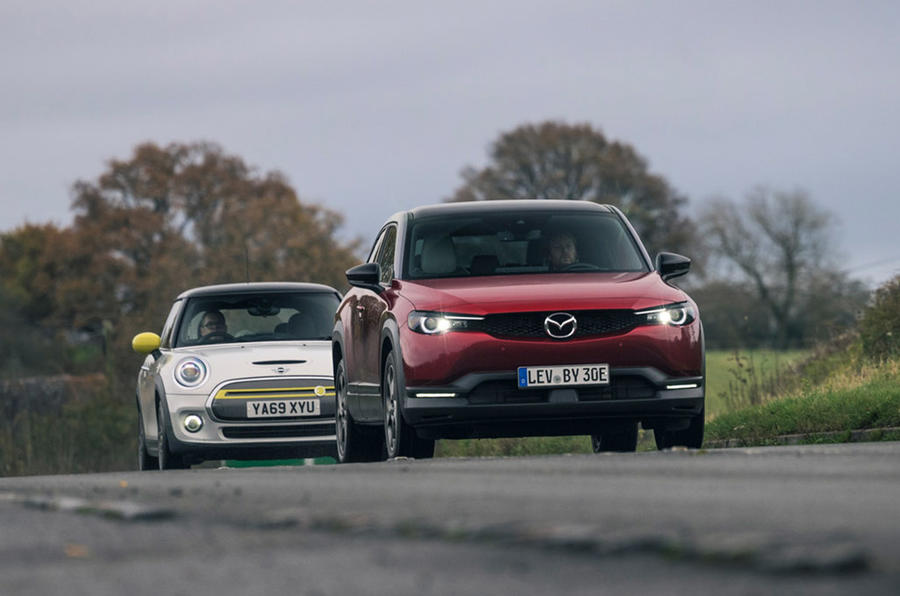Perhaps you’ve been waiting to discover an electric car that’s genuinely good to drive but are bored rigid of reading tributes to the Porsche Taycan (£85,000), Jaguar I-Pace (£64,000) and Polestar 2 (£45,000). Excellent cars all, but crikey, they don’t half make a dent.
Some good news, then. Neither of the EVs in this brief twin test costs more than £28,000 after the government grant for plug-in cars, yet both come from makers who understand the importance of involving the driver. More than that, it could be argued that, at their very best, the Mini Cooper and Mazda MX-5 exemplify what we love about front- and rear-driven sports cars respectively. So even before we’ve unplugged the charging cables, there’s cause for optimism.
The Mini Electric has been out for some time, so it’s already a known quantity. In short, we like it. We especially like its turn of pace (thank you, 199lb ft of slap-bang torque), the trademark fish-bowl view forward, the conspicuous sense that the centre of gravity is grazing the road surface and its well-tuned steering response, which is so important in achieving the ‘go-kart’ agility that Mini frequently references. If you want to buy small and electric but still need that driving buzz, so far this is your best ‘affordable’ option (unless you can find yourself in a Renault Twizy on a wet roundabout).
The only thing we don’t especially like about the model that already accounts for one in 10 new Minis sold is its meagre range. Fully charged, it barely gets 140 miles on the official test cycle, dropping to around 110 miles in the real world. And this isn’t simply a quirk of the supermini segment: the Peugeot e-208 is officially rated at 206 miles and even the new Fiat 500 will manage 199 miles. So while it’s unusually good to pedal about, the Mini cements its ‘second-car’ status before you even flip the bright-yellow toggle that prompts the electricals into life. Only you will know whether or not that’s a deal-breaker.

You might think the Mini’s range would be an opening for the less powerful, 235kg heavier and marginally costlier Mazda MX-30 to exploit and quickly even up the scales for overall appeal. But no. With 124 miles, the first electric Mazda somehow offers even less autonomy than the Mini.





































Join the debate
Add your comment
you keep mentioning how much better the Mini s because it s solow to the ground. AS the years pass is is a serious disadvantage disadvantage, espvially when parked close to a kerb. Dismountingfrom a MIni s next nigh on i,possible.
and your comments on the i3 still being fresh andinnovative, forgot to mention that it is still plug ugly
.jeff box
The range will be a deal breaker for some and would probably be a second car. The thing I struggle with is the range of these vehicles 35kw according to the screen shot of the mini gives you 95 miles range?? This is way below the WLTP figure.
I have a Ioniq which is a bigger car but only has a slightly bigger battery at 38kw so you would think the range is about the same?
Wrong, in winter I am getting about 180 miles of range and in summer about 210 with a high of 225 achieved. This makes no sense? Are the batteries in mine much better or is it driving style?
The Ioniq is the most efficient car in production today, as far as I know.
The Mini isn't *that* much worse though, it matched its WLTP figure in Carwow's range test, just has a weirdly configured range gauge that tends to underreport.
You cannot discuss these as every day options without them having a decent driving range. Has to be 200 miles surely, even for a small car, when they take 5 or more hours to recharge.
Hence Peugeot e208, Renault Zoe long range or Kia eNiro win out against any of these range deficient models for my £30k. I can't even believe I just wrote £30k for an 'affordable' small car!
Pure EV's still have a long way to go to get anywhere near what is available with a combustion engine. We need more power dense battery technology as a first step.
28 minutes for the Mini; 4.5 hours is for home charging (in which time isn't really a factor, you just plug it in when it's sitting idle anyway).
Agreed that they do both need more range, though. The Mini's guess-o-meter is very conservative, it will usually go longer than is indicated, but it's still too low for my liking.